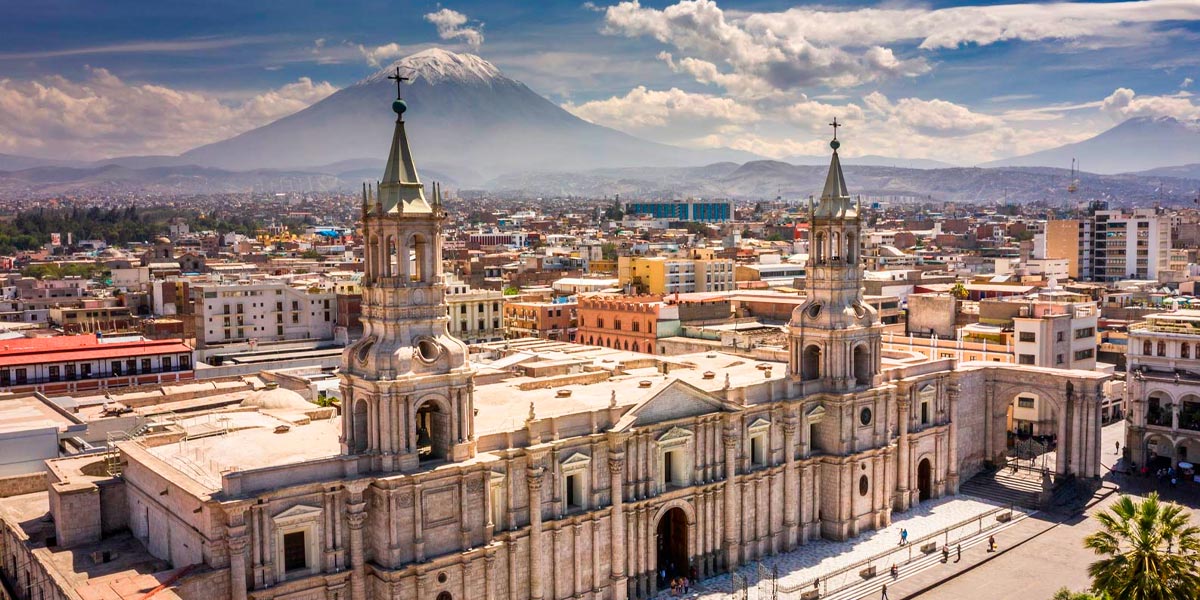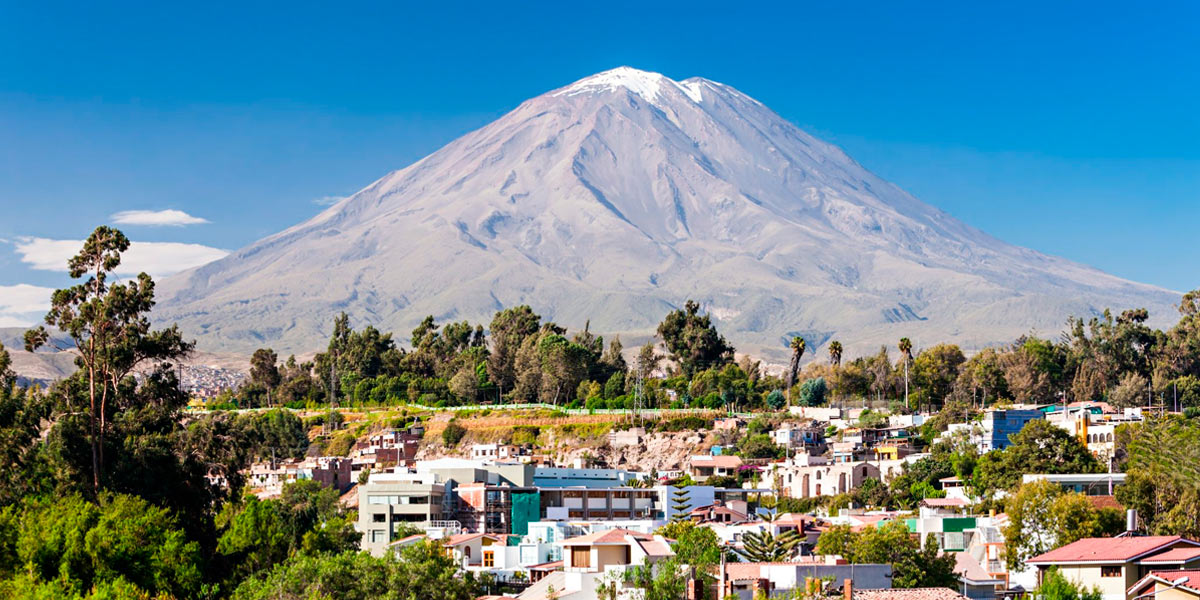Arequipa is one of the most complete destinations in southern Peru. Its mild climate, volcanic landscapes, and cultural appeal make it an ideal place to visit for much of the year. However, depending on the season, the experience can vary.
Whether you prefer sunny days to explore the historic center or clear landscapes to explore the Colca Canyon, knowing the weather conditions and the advantages of each season will allow you to make the most of your visit. So here we will tell you the best time to travel to Arequipa, so you can make your travel plans and choose the type of experience you are looking for.
What is the weather like in Arequipa?
Compared to all other major regions in Peru, the weather in Arequipa is one of the most pleasant climates in the entire country. Situated at over 2,330 meters above sea level, Arequipa is known for its consistently clear, sunny skies with occasional showers, making it pleasant to visit all year round.
There are basically 2 seasons that make up the year:
-
Dry Season
Fortunately, the dry season lasts for most of the year in Arequipa Peru. From April to November, the region has very low humidity, no rain, and temperatures that, although practically the same as in summer, can feel a little cooler due to the dryness of the air.
Here you will be able to experience the best of Arequipa. The colors are more vibrant and the warm weather during the day makes it perfect for exploring the city and enjoying a good meal in the main square.
During the dry season, you can do practically everything, including excursions to the Colca Canyon and Misti Volcano, outdoor sports such as whitewater rafting, or any other tour or activity. -
Rainy season
From December to March, you will find an Arequipa with more clouds, some rain, and higher humidity. Even though the weather is not ideal for doing some outdoor activities, you can still enjoy the city.
As mentioned above, Arequipa's weather tends to be almost perfect all year round, with rainy season months having an average low of 10°C and an average high of 20°C.
If you're traveling at this time of year, we recommend bringing warm clothing. Mainly waterproof jackets, as the rains, if you're unlucky, can be constant. Otherwise, there's nothing to worry about. The low temperatures, as you've seen, are not as extreme as in other destinations (e.g. Puno) and still allow you to enjoy the city to the fullest. If you are one of those people who love rainy and cold days, you will have a great time in Arequipa.
Arequipa Weather Month by Month
| Month | Maximum / Minimum (°C) |
| January | 23° / 12° |
| February | 23° / 12° |
| March | 23° / 12° |
| April | 24° / 11° |
| May | 24° / 10° |
| June | 23° / 9° |
| July | 23° / 9° |
| August | 24° / 9° |
| September | 24° / 10° |
| October | 24° / 10° |
| November | 24° / 10° |
| December | 24° / 11° |
What months does it rain in Arequipa?
Arequipa, the famous White City, is located over 2,300 meters above sea level and has one of the most pleasant climates in southern Peru. Its geographic location, between the Pacific coast and the Andes mountain range, gives it particular climate conditions, where you'll find sunny days almost all year with some seasonal rains. This is worth keeping in mind when planning a trip.
-
The rainiest month
Although Arequipa is known for its dry climate, there is a rainy season that runs from December to March. During this period, rainfall usually occurs sporadically, mainly during the afternoons and evenings. February is the rainiest month of the year, and while it doesn't completely stop tourist activities, it can affect routes to natural areas like the Colca Canyon Peru, the Valley of the Volcanoes, or trekking routes near Misti and Chachani.
During this time, the landscapes become greener, which many travelers value for its visual appeal. However, rains can cause delays or temporary road closures in rural areas, so it's advisable to travel with foresight and check the weather conditions with local agencies. -
Coldest months
While Arequipa maintains a mild climate most of the year, June and July are the coldest months. During the day, the sun remains constant, but at night temperatures can drop to 5°C or less, especially in elevated areas or during excursions outside the urban area. This is more noticeable if you visit places like the Yanahuara viewpoint or if you do activities at dawn, where the cold is more apparent. Therefore, it's recommended to bring thermal clothing, windbreaker jackets, and hats, even if the weather seems warm during the day. -
The warmest month
On the contrary, October is considered the warmest month in the region. Daytime temperatures can exceed 24°C, with mild mornings and sunny afternoons ideal for exploring the historic center, visiting colonial convents, walking through the Andean countryside, or enjoying viewpoints without worrying about rain or cold. This time is also ideal for outdoor excursions or volcano ascents, as climate conditions are more stable.
One of the great advantages of visiting Arequipa is that, outside the rainy season, the rest of the year is dry, with clear skies and good visibility. This favors photography, urban walks, and visits to archaeological or natural sites.
FAQs about the weather in Arequipa
- What is the best time to visit Arequipa?
The ideal season to travel to Arequipa is from May to November, when the weather is drier, the days are sunny, and rain practically disappears. This time is perfect for exploring the historic center, taking outdoor excursions, and visiting the Colca Canyon without weather setbacks. Also, during these months, the city has clear skies, which improves visibility and the experience for those who enjoy photography or Andean landscapes. - How is the climate in Arequipa compared to other cities in Peru?
Arequipa stands out for having one of the most stable and pleasant climates in the country. Unlike Lima, which is often covered by fog for much of the year, and Cusco, which faces intense rains between December and March, Arequipa offers more sunny days and less humidity. However, due to its altitude (over 2,300 meters above sea level), nights can be cold, especially in winter. This combination of warm days and cool nights gives it an attractive balance for those looking for a temperate climate without extremes. - Is it necessary to bring warm clothes all year round?
Yes, although during the day the temperature is usually mild or warm, it's always advisable to bring a light jacket, a sweater, or thermal clothing for the nights. Between June and August, the temperature can drop quite a bit at dusk, and if you plan to visit higher areas like viewpoints or go for walks at dawn, you'll feel the cold more intensely. If you visit Arequipa during the rainy season (December to March), add a waterproof windbreaker or rain poncho to your luggage, as showers can surprise you in the afternoons.
Best Tours in Peru
Many are the routes that take you to Machu Picchu, but none is like the Inca Trail Tours, the most famous pedestrian path in the Americas. After flying from the capital of Perú, Lima, you will arrive in Cusco to walk for four days along a path through forests and dense fog, millenary stone steps and discovering the ruins of ancient fortifications and Inca cities, and all the time enjoying majestic views.
- Peru Adventure Holidays
- Enigmatic Peru
- Peru Full of Adventures
- Peru Luxury Travel
- Peruvian Highlands
- Peru Honeymoon Luxury
- Inca Trekkers
Inca Trail, Machu Picchu and more
- 3 Day Inca Trail Tour
- Short Inca Trail
- One Day Hike Royal Inca Trail
- Machu Picchu Day Trip from Cusco
- Machu Picchu Honeymoon
- 5 Day Salkantay to Short Inca Trail
- Lima & Salkantay Trek to Machu Picchu
- Amazon and Machu Picchu Tour
- Manu Adventures Cusco
If you want to visit Machu Picchu, we recommend you to book your Machu Picchu Ticket in advance, so you will enjoy your Vacation in Machu Picchu without any problem.









